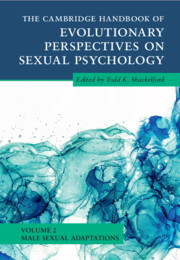Book contents
- The Cambridge Handbook of Evolutionary Perspectives on Sexual Psychology
- The Cambridge Handbook of Evolutionary Perspectives on Sexual Psychology
- Copyright page
- Contents
- Contributors
- Preface
- Part I Precopulatory Adaptations
- Part II Copulatory Adaptations
- Part III Postcopulatory Adaptations
- 14 Postejaculatory Adaptations to Self-Semen Displacement
- 15 Male Mate Retention
- 16 Shifts in Partner Attractiveness
- 17 Emotional Commitment in Men
- 18 Sexual Jealousy in Males
- 19 Men’s Attachment-Related Needs in the Sexual Arena
- 20 Paternal Care
- 21 Paternal Filicide
- Index
- References
14 - Postejaculatory Adaptations to Self-Semen Displacement
from Part III - Postcopulatory Adaptations
Published online by Cambridge University Press: 30 June 2022
- The Cambridge Handbook of Evolutionary Perspectives on Sexual Psychology
- The Cambridge Handbook of Evolutionary Perspectives on Sexual Psychology
- Copyright page
- Contents
- Contributors
- Preface
- Part I Precopulatory Adaptations
- Part II Copulatory Adaptations
- Part III Postcopulatory Adaptations
- 14 Postejaculatory Adaptations to Self-Semen Displacement
- 15 Male Mate Retention
- 16 Shifts in Partner Attractiveness
- 17 Emotional Commitment in Men
- 18 Sexual Jealousy in Males
- 19 Men’s Attachment-Related Needs in the Sexual Arena
- 20 Paternal Care
- 21 Paternal Filicide
- Index
- References
Summary
Unlike extensive research conducted on courtship, foreplay, and intercourse, what happens after ejaculation is one of the most neglected dimensions of human sexual behavior. As described in this chapter, postejaculatory adaptations have important and diverse implications for such things as penis hypersensitivity, the refractory period, female infidelity, sperm competition, semen displacement, self-semen displacement, spousal rape, the risk of transmitting sexually transmitted diseases for uncircumcised men, and the incidence of nonpaternity. This chapter also outlines ways to test the Bruce effect in human females and provides a novel explanation for the absence of the Coolidge effect in women.
- Type
- Chapter
- Information
- Publisher: Cambridge University PressPrint publication year: 2022

